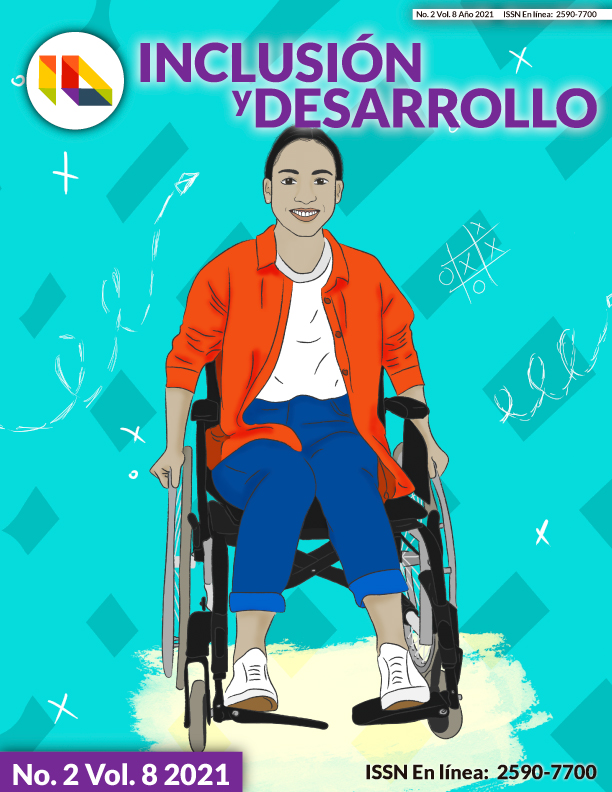Comunidade surda: aproximação à sua cultura na área metropolitana
Barra lateral de artigos
Como Citar
Altmetrics
Detalhes do artigo

Este trabalho está licenciado sob uma licença Creative Commons Attribution 4.0 International License.
Conteúdo do artigo principal
Resumo
O presente estudo pretendeu descrever a cultura surda na área metropolitana. Qualitativo etnográfico em que foram recolhidos dados através de entrevistas semiestruturadas a intérpretes e pessoas surdas, exploração de redes sociais, leitura de artigos indexados e de reflexão, Navegação em sítios web de associações de surdos e de observadores não participantes na comunidade; a informação foi subsequentemente categorizada e analisada. Encontrou-se uma cultura com valores mesmos que surgem dentro dos ambientes de socialização e luta por necessidades em matéria de comunicação e acesso a diversos espaços e papéis. Não é possível generalizar a cultura surda da área metropolitana a outras culturas, assim como acontece também com população ouvinte. Identifica-se a incidência da língua de sinais na construção de interações costumes e crenças facilitando a constituição de todos os elementos que a estabelecem como comunidade e cultura. Identificaram-se estudos de culturas surdas (App nível internacional em países hispano-falantes) de países distintos à Colômbia, coincidindo na identificação desta população com língua materna diferente da de sua nação. É importante socialmente o reconhecimento da situação actual deste grupo social, com necessidades e características especiais que requerem visibilidade. A comunidade surda da área metropolitana é diversa tanto em sua capacidade comunicacional dentro do mesmo território e distinto vocabulário segundo a região do país, o que dificulta desagregar suas diferenças para identificar aspectos em comum da comunidade.
Referências
Barreto, A., & Cortés, Y. (2014). Aspectos relevantes del discurso en Lengua de Señas Colombiana (lsc). http://repositorio.ucam.edu/bitstream/handle/10952/1217/ TFM%20MODS%202014 %20JOHN%20RICHARD%20JIMENEZ.pdf?isAllowed=y&sequence=1.
Calderón, A. (2014). La construcción cultural del sujeto sordo. Revista do núcleo de antropología urbana da USP, (14).https://doi.org/10.4000/pontourbe.1671.
De la Paz, M. & Salucci, M. (2009). Elementos de la cultura sorda: Una base para el currículum intercultural. REXE. Revista de estudios y experiencias en educación, 8(15), 31-49.
Escobar, R. (2019). Alfabetización de modelos lingüísticos jóvenes y adultos para la comunidad sorda: la historia de la lengua de señas colombiana. Trabajo de grado (pregrado), Universidad Pedagógica Nacional. http://hdl.handle.net/20.500.12209/10768.
Frigola, S. (2010). La comunidad sorda de Catalunya. Les llengües de signes com a llengües minoritàries: perspectives lingüístiques, socials i polítiques, Barcelona: Institut d’Estudis Catalans, 29-54. DOI: 10.2436/15.0100.01.25.
Instituto Nacional para Sordos (2011). Boletín: Observatorio social Población Sorda colombiana - Contribuyendo a la construcción de una sociedad incluyente y participativa para la población sorda en Colombia. www.insor.gov.co/home/wp-content/uploads/filebase/publicaciones/boletin_observatorio02.pdf.
Jiménez, J.R. (2015). Educación para el trabajo y ubicación laboral de la comunidad sorda en Colombia. UCAM. http://repositorio.ucam.edu/bitstream/handle/10952/1217/TFM%20MODS%202014 %20JOHN%20RICHARD%20JIMENEZ.pdf?isAllowed=y&sequence=1.
Keller, H. (2003). Apuntes para una sociología de la comunidad sorda. Educación y biblioteca, 138, 50. https://bit.ly/2Hmt15G.
Molina, L., Ipiña, M., Reyna, C. & Guzmán, R. (2011). Competencia social en niños con sordera profunda. Revista CESPsicología, 4(1) ,1-15. https://www.redalyc.org/articulo.oa?id=423539418002.
Montero, M. (2004). Introducción a la psicología comunitaria. Desarrollo, conceptos y procesos. Editorial Paidós.
Organización de las Naciones Unidas para la Educación, la Ciencia y la Cultura (1982). Conferencia Mundial sobre las Políticas Culturales. http://www.unesco.org/new/es/mexico/work-areas/culture/
Organización Mundial de la Salud (15 de marzo de 2019). Sordera y pérdida de la audición. https://www.who.int/es/newsroom/fact-sheets/detail/deafness-and-hearing-loss.
Oviedo, A. (2013). La cultura sorda. Notas para abordar un concepto emergente. III Congreso Internacional con sede en Buenos Aires. V Congreso latinoamericano. VI Congreso Nacional de salud mental y sordera: “una nueva mirada de la sordera: en lo personal, familiar y social”. http://repositoriocdpd.net:8080/bitstream/handle/123456789/255/Pon_CulturaSordaConcepto_2013.pdf?sequence=1.
Palacios, A. (2008). El modelo social de discapacidad: orígenes, caracterización y plasmación en la Convención Internacional sobre los Derechos de las Personas con Discapacidad. Cermi.
Pérez, Ó. (2014). Las personas sordas como minoría cultural y lingüística. DILEMATA, 15, 267-287. http://repositoriocdpd.net:8080/handle/123456789/1025.
Rivera, G. (2009). Comunidad y Sentido de Comunidad. Tesis de grado, facultad de ciencias sociales, Universidad de Chile, Santiago. http://repositorio.uchile.cl/tesis/uchile/2009/cs-meza_g/ pdfAmont/cs-meza_g.pdf.
Saldarriaga, B. C. (2014). Personas sordas y diferencia cultural, representaciones hegemónicas y críticas de la sordera.https://repositorio.unal.edu.co/handle/unal/52064.
Sánchez, F. (2016). Manos otras, miradas otras, silencios otros. Resignificaciones culturales hacia una música propiamente sorda. UNAM. https://www.researchgate.net/publication/ 331635551_Manos_otras_miradas_otras_silencios_otrosResignificaciones_culturales_hacia_una_musica_propiamente_Sorda.
Soriano, F. C., & López, L. (2009). Discapacidad y cultura: desafío emergente en investigación. Avances en enfermería, 27(1), 110-123. https://revistas.unal.edu.co/index.php/ avenferm/article/view/12960.
Vite, I. & Fernández-Viader, M. (2017). Sordera y el cuarto objetivo del desarrollo sostenible (ODS4): Propuesta de un proyecto de RED para la educación bilingüe de los sordos bajo el marco europeo. Regions and Cohesion, 7(1), 19-39. DOI:https://doi.org/10.3167/reco.2017.070104.
Vygotsky, L. (1995). Pensamiento y lenguaje: Teoría del desarrollo cultural de las funciones psíquicas. Ediciones Fausto.https://www.academia.edu/ 31973609/Pensamiento_y_Lenguaje_Vigotsky.





